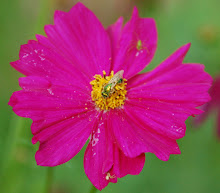
I just got home from my first day of a week-long Master Gardener Entomology Specialist Training. It was fabulous. So interesting. By the end of the week I should be able to identify the bug my husband found in my new herb bed. And I should know not to call it a bug but more properly an insect.
Until then, I thought I would keep track of some of the most fascinating tidbits of today's class.
--Ants walk in line by sending each other chemical cues.
--Insects are the most diverse form of life on the planet. There are 30 million species.
--Not all insects have wings but if you see an insect with wings, it is an adult and will not grow any more. In other words, if you see a small grasshopper with wings, it will not grow into a bigger grasshopper. If you see a larger grasshopper, it's a different species.
--Only female insects sting. They have ovapositors, an appendage for laying eggs and for defense. So if a fire ant stings you, it was a lady.
--The exoskeleton of insects keeps it from drying out, not from drowning, which is how diatomaceous earth kills many insects. It's a dessicant and makes holes in the exoskeleton allowing water to seep out.
--Horticultural oils work by clogging the spiracles and preventing insects from getting oxygen.
--The cicada shells that we often see around are the last molt of a cicada nymph. All the previous molts occurred underground. For the final molt the cicada grabs on to a sturdy surface, like Iris's signs, splits through its head, and then continues the molt down the body.
--Even bug geeks like to have fun: Q. Wheeler and K. Miller named three species of slime mold beetles: Agathidium bushi, Agathidium cheneyi, and Agathidium rumsfeldi. They claim the naming is an homage.
--A German cockroach can lay up to 36 eggs at one time.
--There are many different types of fleas including cat fleas, dog fleas, squirrel fleas, and rat fleas. Some fleas are very species specific.
--Most fleas in Texas are cat fleas, which will live on any furred animal. If you have fleas but no furred pets, you've got a furred animal somewhere in your house.-)
--Some flies have no mouth parts so they die fairly quickly after reaching adulthood.
The rest of the week will include specimen gathering--we get a really cool insect kit with the class--at a few spots around town, and detailed information on more classes of insects. I can't wait!
***Gee, do I have frass on my face! My mystery bug not only isn't a bug it's not even an insect. It's a spider, a jumping spider. Spiders and insects are both anthropods, but spiders are not insects. I actually learned this yesterday (and probably knew it before and had forgotten) but had forgotten again by last night.
I think one of the reasons I've so enjoyed learning about all gardening aspects is that I know so little. After years of accumulating more knowledge in narrower areas, it's refreshing--and completely humbling--to jump into a new arena. And because I care less about looking like a fool as I age, I have no problem asking questions and revealing my utter ignorance.
But I still appreciate Annie in Austin's very sweet way of letting me know I know so little!


YOu have peeked my interest in specialist training. Let us know what your mystery bug is!
ReplyDeleteI love studying insects and took two entomology classes in college. They are very interesting! My favorite insect is the Buffalo Treehopper. What's yours?!
ReplyDeleteThe class sounds interesting, Vertie! We've seen one weird critter after another since we moved to Texas and identifying them can be a real game.
ReplyDeleteIs that your mystery bug in the photo? Looks like 8 legs to me, so you probably won't find it in under insects but under arachnids with stuff like spiders.
Annie at the Transplantable Rose
Thanks for sharing those highlights! I don't think I knew any of those facts.
ReplyDelete